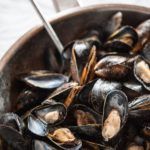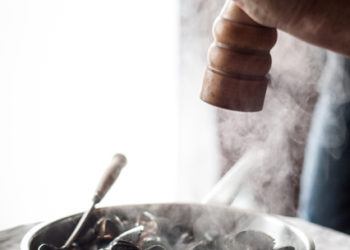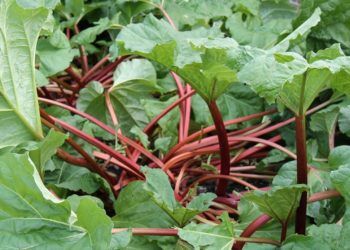Note: When I wrote this article in 1994, there was an excitement about the connection between Sonoma County and Provence that blossomed quickly. Shortly after the article appeared, it was translated into French and circulated in that country. I was asked to help forge a sister region relationship, which I did, and then Sonoma County was invited to have a booth at the agricultural fair in Aix-en-Provence. With help, I managed to take Sonoma County olive oils–there were just a few at that point–and other products, including wines from about 14 wineries–to the fair. When I returned, we–myself and a couple of colleagues–founded the Sonoma Provence Exchange, which thrived for several years, until our parent organization floundered and then vanished. This piece is as I wrote it then, a snapshot in time.
The story of Berkeley wine merchant Kermit Lynch’s entrance into the south of France could very well be a description of the effect Sonoma County has both on residents who take a few minutes to travel our countryside and on the visitors who come here from all over the United States to bask in our glorious, expansive landscape and idyllic climate. It is a sensation I feel whenever I get a moment to travel one of my favorite back roads and take in the breathtaking view of, say, the sea from high above Coleman Valley Road or the narrow winding section of Riebli Road that passes through what appears to be the remnants of a working farm, images that never fail to make me think of Europe, of France, and often, of Provence specifically.
C’est la Provence ici
I am not the only one to see such a resonance between the two landscapes.
Parisians arrive, take a look at our huge blue sky and rolling golden hills and say to their hosts, “Ah, c’est la Provence ici.”
It is not just the open, agricultural areas of Sonoma, nor the nearby Pacific ocean; there is something about the size of the sky, the way the sun hits the far hills at dusk, the luminous light of fall, that stirs a physical resonance in people. They try to give it voice and more often than not, it comes out “Provence”.
Provençe is a region in southern France that stretches westward from Italy and the Cote d’Azur to the Languedoc. Its northern borders embrace the Southern Rhone region, the location of one of the world’s great wine appellations, Châteauneuf-du-Pape; and is bordered on the south by the Mediterranean Sea. The region is troubled by cycles of drought and flood, and much of the soil of Provençe is rocky and infertile, hospitable to grapevines and olive trees but not much else. The light, the sky, and the spectacular sun are legendary. The shade of blue of the sky, the writer Colette wrote decades ago, “elsewhere is but a dream”. For two millennium, the siren call of Provençe has beckoned travelers to her rocky terrain. The Greeks, enchanted, established a colony that became Marseilles; the Romans claimed the region as La Province, planted its first grapevines, and built its roads. Artists, too, have found it irresistible: Picasso, Cézanne, Man Ray, Marc Chagall, all worked there. The Chapelle du Rosaire in Vençois was designed and decorated by Henri Matisse between 1947 and 1951; he considered it his masterpiece.
The seaport of Marseilles is arguably the most famous city of Provence, though Aix-en-Provençe is quite well-known, too. M. F. K. Fisher, who spent the last 20 or so years of her life in Glen Ellen <<we’ll link to my story about Glen Ellen not yet posted>>, captured the two cities forever with her characteristically vivid, evocative prose in A Considerable Town, her story of Marseilles, and Map of Another Town, about Aix. She spoke of the dry, parched hills of Provençe as resembling the folds of the tawny brown coat of a resting lion, an image she surely saw around her in the dry, parched land along Highway 12. More recently, A Year in Provence and Toujours Provence, both best sellers, by Peter Mayle have piqued the American interest in the French countryside.
A Huge Sky, Sweeping Valleys, a Seacoast
For decades, the comparisons between Sonoma and Provençe were born of simple, unselfconscious observation, of the inevitable resemblance of any one wine-growing region to another and because of basic geographical correspondences between two areas that are separated by thousands of miles but only by about 5 degrees of latitude and that enjoy a seacoast. Provençe, the southernmost portion of coastal France (only the Pyrenees reach farther south), is actually farther north than Sonoma; We are on an approximate parallel with southern Italy and Sicily, but the similarities between the landscapes are unmistakable, the huge sky, the sweeping valleys that extend towards the dry, undulating hills, the grazing sheep and cattle, the ubiquitous vineyards. This resonance extends beyond both the borders of Provençe and those of Sonoma County; many see similarities between Northern California and France in general, except, of course, Paris, to which nothing anywhere compares.
In the last decade or so this intimate resonance between Sonoma and Provençe has become more intentional and conscious, and is mentioned with increasing frequency. But how valid is it, really? Is it just a romantic notion we have of ourselves or do the similarities run deeper than the flow of wine and the scent of the sea? Like the best wines, the answer is complex.
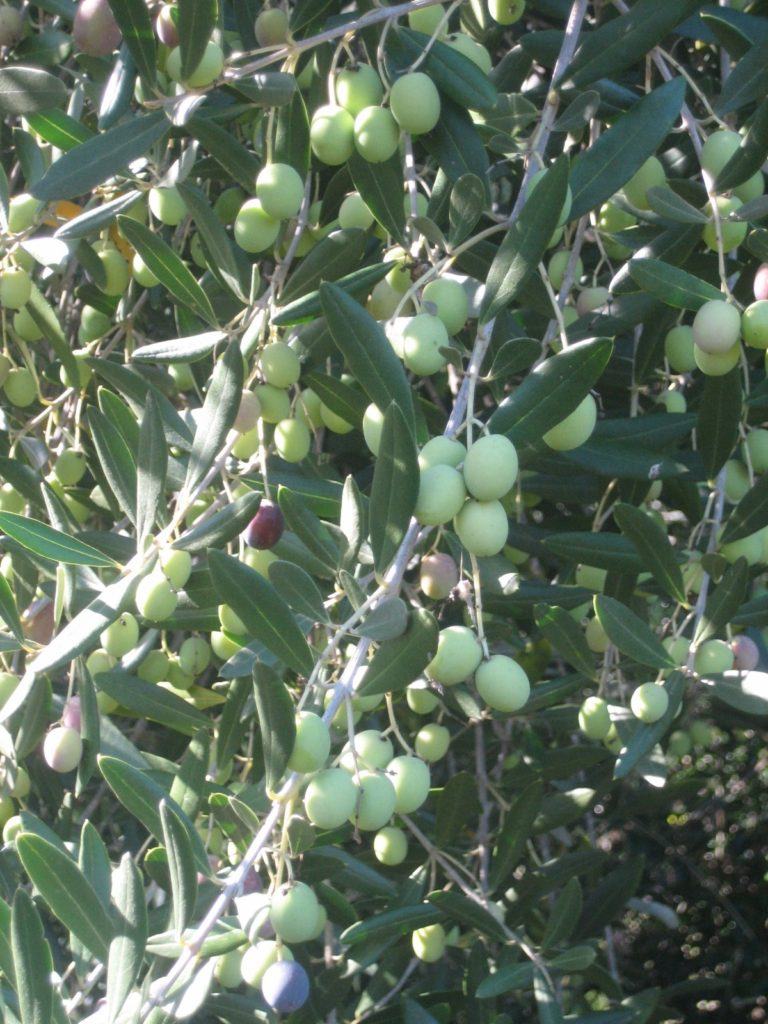
Olives and mills to process them into oil dot the landscape in both Provence and Sonoma.
The more a person knows Provençe, the more they appear to appreciate the comparison. Barry Sterling of Iron Horse Vineyards owned a house on the Cote d’Azur on the eastern edge of Provençe for twenty-five years. “The most striking dissimilarity is, of course, between French and Americans,” he said during a recent conversation. “We are very different people, but the similarities go beyond wine and olives, which are obvious. There is an emphasis on food in both regions, not just on its preparation but on the produce. Provençe produces a great deal of fruit and melons, similar to what grows well here. There is Provençal lamb and Sonoma lamb and, of course, lavender grows lavishly in both areas.”
Lavender as far as the eye can see
Lavender is of considerable significance in the comparison between Provençe and Sonoma County. In certain areas of southeastern France, there is enormous acreage devoted to lavender which is harvested and distilled for the French perfume industry. Near Grasse, the air is saturated with the scent for months at a time and hillsides are purple as far as the eye can see. So intense is the fragrance that it is said to interfere with the pleasures of the palate. What can you taste when all you smell is lavender? Such concentration of lavender has not yet come to SonomaCounty, but Sandra MacIver, founder of Matanzas Creek Winery in southeastern Santa Rosa, has made a striking start.
“A writer who had been out here for the wine auction was inspired and made first mention of the comparison, or the first that I heard,” Sandra MacIver offered, referring most likely to an off-hand comment in W in the summer of 1988 that captured the county’s attention, including that of Gaye LeBaron, who mentioned the Provençe-Sonoma comparison in her column. Sandra loved the image, was inspired, and eventually created the two-and-a-half acre lavender field at the entrance to the winery, though it was not a direct attempt to evoke Provençe that led to its creation.
The MacIver’s lifestyle evokes Provençe in many ways. They live in an olive grove with geese and ducks wandering around, and their lives center on their winery. It was when they were looking for a getaway along the coast that lavender first came into their lives. They were searching for a house that had a bright, fragrant garden and found it in the northwestern corner of the village of Mendocino. Sandra was inspired by the garden full of lavender, which thrived in spite of all the salty residue from the sea, and she decided to try it at the winery, a project which combined two thoughts, landscaping for beauty as well as for a crop. The hope was that the lavender would generate enough revenue to pay for the landscaping.
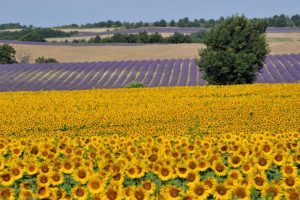
Fields of sunflowers and lavender, in Provence
In addition to selling both fresh and dried lavender, Matanzas Creek Winery has developed a line of lavender products, some of which are already for sale, like lavender sticks for grilling. Work continues on an oak-aged chardonnay vinegar scented with lavender; spice mixtures and tea blends; and black lavender honey, gathered for the first time this year. They began with just two hives and discovered that the lavender could have supported more. The bees are extremely happy, Sandra says, and the field buzzes so loudly it sounds like it’s going to take off. Here is another direct comparison in the making: To those who know about it, Provençal honey is highly prized.
Cows, Ancient Olive Trees, Old Grapevines
A new PBS series, scheduled to begin broadcast in January, 1995, draws direct comparison between the two regions. “You may think you are looking at Provençe,” says co-host Karen MacNeil as the camera pans the grounds of Matanzas Creek, “but this is actually Sonoma County, California.” The 13-part series, “Good Taste – A Guide to Food and Wine” is being underwritten primarily by Oregon Public Broadcasting and will be filmed in California, Oregon, Washington, Texas, and New York. MacNeil, one of the few women wine writers in this country and former wine correspondent for the “Today” show, has a singularly romantic view of the connection between Sonoma and Provençe. “Matanzas Creek in particular makes a visual parallel with the south of France,” she says, mentioning the parched infertile hills. “You see cows, ancient olive trees, and old grapevines in both places.” She sees more than the physical resemblance, however. “There is an immediate physical connection between the two – but equal to that is the spiritual-cultural connection. Both areas are tied to the land in a very intimate way. Sonoma – certainly in contrast to Napa – says: ‘Let’s just stay on our land and never go to New York.’ In Provençe, they drink their wine, eat their olive oil, and say among themselves, ‘Why go to Paris?’”
Rick Theis, executive director of the Meritage Association, candidate for Santa Rosa City Council, and avowed Francophile, has a different perspective. “Like most things that deal with image, it exists mostly in the imagination, but it is a wonderful comparison,” he says, continuing, “If people have visited Provençe, they know the life and land have certain similarities but that the lifestyles are significantly different. We would like to emulate the lifestyle of Provençe, I think, if only we had the time.”
Theis has never been to Provençe, but he makes an essential point. Much of what we admire and like to think we could emulate is really a peasant lifestyle of hard work tied closely to the land. What they do out of necessity we do because of its charm and appeal, when and if we have the time and the resources. Ironically, in this country it is largely the moneyed class that can indulge in this way of living. Very few us make a decision about what to eat at noon based upon what comes off the boats at 8:00 a.m., a common practice along the coastal towns of the Mediterranean.
Similarly, Americans rely upon central supermarkets for the bulk of their needs and frequently do their shopping a week at a time, while the French depend upon their open markets not only in Provençe but throughout France and visit them daily. The French markets are spectacular, full of fresh and aged cheeses, olives, fish from nearby seaports, bins of olives, vegetables picked that morning, pristine fruit. Our farm markets resemble those of France, though on a much smaller scale. Here, health department regulations prohibit the possibility of such abundance. We could never sell, say, fresh fish at an outdoor market. Even the regulations for selling cheese are prohibitive and you rarely see it in a farm market in Sonoma County. Still, the produce in our markets is bountiful, yet how few of us take advantage of it on a regular basis. We do not demand, even here in one of the best growing regions in the country, the impeccable freshness of produce that Frenchmen seem to take as a simple birthright. But things are changing, even in the countryside of Provençe. Barry Sterling sold his house in part because he could no longer buy fresh produce in his village, which leads to another correspondence, though not a happy one, between the two places.
Loss of Agricultural Land
One of the most dramatic similarities between Sonoma and Provençe is development and the resulting loss of agricultural land. The war between those with the financial resources and inclination to exploit the region and thus destroy its character and those who wish to preserve it must be fought on both soils. The losses in both Sonoma and Provençe are heart-wrenching and in many cases, irretrievable. An ancient vineyard ripped out and replaced with apartment buildings is gone forever. Kermit Lynch is passionate on this subject, and tells the story of Lucien Peyraud, proprietor of the highly acclaimed Domaine Tempier in Bandol in the very south of Provençe, and his opposition to the autoroute which eventually cut “a noisy, noxious swath through what was, since mankind appeared, an enchanted valley.” Lynch tells a story that easily could be about, say, Rohnert Park or Windsor.
“ . . . there was nothing funny about his fear of the autoroute and the new housing developments. The autoroute did more than bring noise and pollution. Bandol is now a thirty-minute drive from Marseilles. One can now commute from the Bandol area to earn a living in the metropolis. The land becomes more valuable for living space than for what it can produce, and we in the United States know what that can mean. You work in a downtown office and drive through heavy traffic to sleep in your housing tract, where the rural quality has been destroyed. The French taste displayed in these modern housing developments is immoderately tacky.”
Sound familiar? If not, it should; just look around you. Real estate developers are onto the connection, and several housing developments in Sonoma bear names that reference, however ironically, Provençe.
The change in Provençe continues to spread, Barry Sterling informed me. It is now the in place to buy a house and there is an enormous influx of outsiders and foreigners trying to get a taste of the romantic country life. In the Cote d’Azur, tracts and developments of faux farm houses are replacing ancient homes, the same thing that we’re fighting here. There are more decorator shops and antique stores in the smaller Provencal towns and, as Sterling so colorfully put it, “There has been a disappearance of the butcher, the baker, the candlestick maker and they have been replaced by tee-shirt stores and designer candle shops. Because property values have gotten so high in the Cote d’Azur, this trend is moving from east to west. The French government is encouraging it because they want to encourage growth away from Paris.” Both regions must fight to preserve their land and their character, their very souls, or both will be lost forever.
Michael Dimock, who does promotional work for Select Sonoma County (formerly SCAMP), talks about what he thinks could save the rural character of Sonoma, indeed, of the entire north coast of California. It should be marketed to tourists as the Provençe of America. We should entice visitors here for the romantic country experience that is declining everywhere else. Dimock sees this as the way to preserve our land and our character, though he is not at all optimistic that it will happen. He sees too many warring factions working at cross-purposes, too much tunnel vision, and not enough promotional funds to rescue the Provençal character of Sonoma from developers of tracts and shopping malls. But still, work continues. Dimock is the member of a small group of lawyers, financiers, and restaurateurs who meet on a semi-regular basis at Mixx restaurant on Railroad Square with the purpose of establishing a permanent produce market for Sonoma County products. Those involved in the project see themselves as working in part to preserve the Provençal character of Sonoma.
Sonoma & Provence
Sonoma and Provençe. It is a comfortably romantic vision, and one that can calm one’s wanderlust a bit, at least for a while. But many of the most striking characteristics of Provençe are missing from our landscape. There are no Roman ruins, no fortresses or high castle walls. In towns and villages all over Provençe, the sound of trickling water beckons the traveler to the centers of town, where fountains sing their praises of our most valuable liquid. Wood-burning ovens, when we find them here, are the product of restaurateurs, winemakers, and others with the time and money to allow such an indulgence; in Provençe, they are a basic part of how life is lived, not a gentleman’s luxury. The charm of narrow, cobblestone streets must be found in an ancient land, not in an adolescent state of pioneers, settlers, and immigrants, and that is who nearly all of us are in California. Even if we were born here, what about our parents, or their parents? We go back very few generations and it is the sense of the passage of time, of the progression of human history that provides so much of the appeal of Europe, including France and her Provençe. Do not forget that California was once someone else’s land and they lived in a very different way, quite unlike how we live now and not at all similar to the Provençaux. Our cultural memories come from other lands; we are a people whose roots sink down not into this soil but rather into the ancient terrain of the homes of our grandparents and their parents. Our ancestral memories, if we have such a thing and I believe we do, are stirred by the ways in which the countryside evokes another time, another place. So in this sense, Sonoma County, California, the West, is reminiscent of many lands and cultures. Yet there is a physical reality, too, and one particular to the nature of this landscape; this resemblance, however bold or subtle, to Provençe is unmistakable.
It is twilight and the sky is an enormous swirl of changing color and light, like the inside of an abalone shell or a finely crafted porcelain bowl. After pruning 30 or so lavender bushes, the scent surrounds me in a fragrant sensual cloud. On the table sit the fruits and vegetables I gathered this morning at the Sebastopol farmer’s market: a plump tomato, a basket of tiny sweeter-than-sugar strawberries with their stems attached, miniscule haricots verts, a small white eggplant, golden new potatoes, a yellow pepper, red chard picked this morning. I have a chunk of goat cheese in the refrigerator; there’s a basket of garlic nearby and I will pound a handful of it into a paste to mix with an unfiltered olive oil. As the sun sinks down behind the hills, dinner is ready and I pour the wine, listening to the satisfying splash as it fills the glass. I sit back on the deck with my platter of vegetables, aioli, cheese, and wine, watching the stars emerge: Ah, c’est La Provençe ici, or as close as I can get for now.



